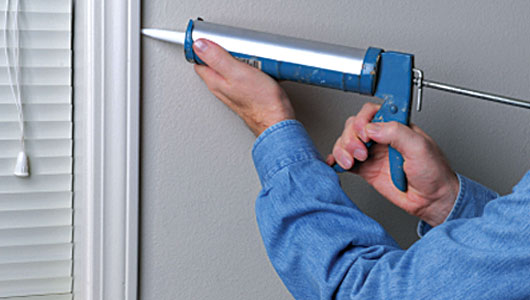Six Easy Steps to Mastering the Caulk Gun to Save Energy and Money
Cut Energy Bills Using Caulking
By Spike Carlsen
Despite your best efforts, your energy bills aren’t as low as you think they should be and it seems that your house continues to leak energy. Sound familiar? The good news: There are steps you can take today, regardless of budget, to maximize your energy savings. All you need is a little know-how, the right tools, and a few hours of time.
First, let’s tackle the leaks in your home. Simple leaks can essentially zap a home’s energy efficiency by 5% to 30%.1 The first—and one of the most important—step I suggest for all homeowners seeking to save energy is to locate the leaks and seal them properly.
Home air sealing, which is sealing leaks with caulk, foam, or weather stripping, reduces energy loss, decreases energy use, and most importantly saves you money. Leaks not only impact utility bills, but also diminish returns on other energy upgrades, which must work harder in inefficient homes. Caulking, when done correctly, is one of the quickest, easiest most budget-friendly ways to weatherize a home.
With more than 43 percent of an average American utility bill going towards heating and cooling2, the estimated savings of 10 percent or more produced by home air sealing3 is welcome news!
Don’t be left in the cold this winter. Instead, follow my six easy steps below on how to find and seal the leaks. Soon you too will be master of the caulk gun!
1. Find the Leaks
Leaks usually occur around the outside of a home and in non-regulated temperature areas like attics and basements that are exposed to harsh elements throughout the year. Obvious areas include the frames around windows and doors, and make sure to pay close attention to where the floor frame rests on the foundation on the inside of a house and where siding meets the corner boards on the exterior. Other areas prone to leakage include: around the chimney, plumbing pipes, wires, and other penetrations in the ceiling. Inspect your insulation for signs of dirt; as this is a tell-tale sign of air leakage.
2. Choose the Right Caulk
The benefits of weatherizing or sealing a home should last. Yet, not all caulk provides energy savings over time. Silicone does. Unlike acrylic, 100 percent silicone is permanently flexible, shrink-proof, crack-proof and waterproof. In fact, 100 percent silicone remains unaffected by all weather and temperature conditions, so it helps prevent gaps and cracks, through which energy dollars can pass, from reforming. GE Silicone II* Window & Door, which is 100 percent silicone, is rain- ready within 3 hours and sun- and freeze-proof. Looking for a caulk that lasts like a silicone but is paintable? Try new Groov by GE*. Just like 100 percent silicone, Groov caulk will never shrink, crack or break down, and because it tools easily like acrylic, even a novice picking up a caulk gun for the first time can get professional-looking results.
3. Clean the Surface
Remove old caulk, dirt, and loose particles with a caulk-removing tool or wire brush. Make sure the surface is dry. Apply masking tape to either side of the joint to create a straight edge. Remove immediately after caulk application.
4. Prep the Tube and Seal
Cut nozzle to desired bead size. Pierce the inner seal with a stiff wire or other similar object. Insert cartridge into caulking gun. Hold the caulking gun at a 45-degree angle and seal around unsightly cracks or spaces inside and outside the home. Keep a steady, constant grip and try to get as long of a bead as you can; then repeat.
5. Smooth the Caulk Seal
Use your finger or a wet caulk-smoothing tool within two to five minutes of application.
6. Store the Tube and Clean Up
Squeeze the caulk until it’s barely coming out of the tube to eliminate air in the tube. Replace the cap, or use a nail in the tube opening. Wipe hands with a dry cloth before washing with soap and water. Use mineral spirits to clean up.
For step-by-step photos to guide you through your project see www.caulkandsave.com. Now, get out and enjoy fall’s sunny, crisp air. You’ve taken a critical step in prepping your home for winter.
—
Spike Carlsen is the former executive editor of Family Handyman magazine and the author of The Family Handyman’s Save Energy to Save Money series. He has teamed up with the manufacturers of GE sealants to offer homeowners clear, practical advice on how to maximize energy savings this season.














Best Advice – If you are gonna be using it much, buy a good dripless caulking gun.
Best Caulk – Benjamin Moore Lifetime
Best Clear Sealant – Lexel